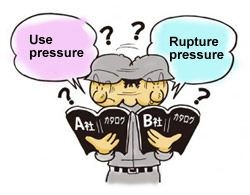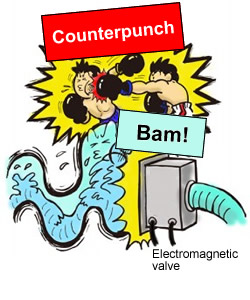Hose and Coupling Knowledge Base
If You Register to Become a Web Member, We Will Send You the Latest Information on Hoses and Coupling.
How to Read Catalog Specifications, Part 1 – Use Pressure

Although a person’s blood pressure should drop in summer, during the hottest days, it may rise, until at last the heat eases.
Blood pressure: As the term implies, blood pressure refers to the pressure of blood, and if it is too high, it may cause weaker blood vessels to burst, which may result in death.
Normal blood pressure to avoid such health problems is defined as less than 130 mmHg for the systolic blood pressure (during contraction) and 85 mmHg for the diastolic (during expansion).
Whoops! This is not a health lesson…
Like blood vessels, hoses have a normal “blood pressure range.” It is called the pressure use range. Although actual performance depends on a variety of factors, Toyox provides pressure specifications to indicate the range for safe, problem-free use. The unit we use is pascals, usually as MPa or kPa. The pressure a hose can withstand is greatly affected by the ambient temperature and other factors, and generally decreases as the temperature rises.
Hose catalogs often list a normal use pressure and a rupture pressure. The normal use pressure indicates the pressure under specific use conditions. The rupture pressure is the pressure at which the hose will rupture, and is considerably higher than the normal use pressure. To use running as a metaphor, the rupture pressure is like sprinting at full speed, and the normal use pressure, which is set for long-term use, is about one-third to one-fifth of the rupture pressure.
Another type of pressure is the impact pressure, which is the momentary pressure applied when a fluid flowing at a fixed rate stops (such as with an electromagnetic valve). This pressure may be as great as three or four times the pressure up to that point. It is like a counterpunch in boxing. In situations where an impact pressure is applied frequently, it is recommended to lower the normal use pressure is recommended.

Archive
How to Cut Steel-Wire-Reinforced PVC Hose
Does Electricity Conservation Increase Condensation?
Why Do Hoses Leak & Disconnect?
Can PVC & Other Plastic Hoses Be Used for Fuel Gas & Kerosene?
How to Read Catalog Specifications, Part 4 – Are Hose Sizes Random?
How to Read Catalog Specifications, Part 3 – Minimum Bend Radius
Beware of Static Electricity on Hoses
How to Read Catalog Specifications, Part 2 – Negative Pressure+B10
About REACH, RoHS, Endocrine Disruptor & the Food Sanitation Act
How to Read Catalog Specifications, Part 1 – Use Pressure
How to Avoid Damage Caused by Ultraviolet Rays
The Dangers of Hose Condensation
Why Transparent Hoses Become Cloudy
Leaks & Disconnections Due to Mismatched Couplings & Hoses
Causes & Solutions for Leaks & Disconnections
The Benefits of the Right Hose for the Situation (2)









